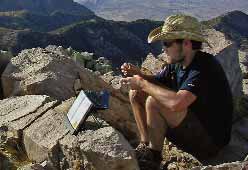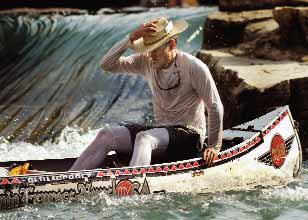SEJournal Online is the digital news magazine of the Society of Environmental Journalists. Learn more about SEJournal Online, including submission, subscription and advertising information.
Inside Story
By NADIA WHITE
|
|
|
Preparing to post a blog from the field via BGAN satellite uplink, reporter Colin McDonald sets up his office in Big Bend National Park, Texas. |
"If you're going to write about the environment, you’d better go see it."
In 2008, reporter Colin McDonald moved from Seattle toTexas by first shifting the starting line further north. His 600-mile paddle from Ketchikan, Alaska, to Seattle was an homage to the watery landscape of his youth. The trip also established his credibility as a journalist who was able to go to inaccessible places and return home with a story. Since then, McDonald, who has a degree in environmental journalism from Western Washington University, has built his newspaper career at the intersection of environmental news and adventure writing.
In 2009, he kayaked the entire coast of Texas for his new job as the water reporter at the San Antonio Express-News. That “Uncharted Coast” project explored how Texans live in a coastal landscape that changes with every storm, and how that environment is shaped by industries struggling to stay put.
Then, McDonald hiked 140 miles through the desert to preview a hiking trail proposed to connect three large pockets of public land in the Big Bend area. More recently, he floated the Devils River with state officials concerned about the impact greater access would have on the state’s cleanest waterway.
Although each of these outings has been physically rigorous and presented the logistical challenges of outdoor adventure, McDonald said in a recent interview that the process of reporting should not be allowed to upstage the issue at the heart of the story.
“At its best, it’s another tool to help tell stories,” McDonald said.
“For me, at the most basic, if you’re going to write about a watershed you should know that watershed. You should know what the ridges look like and you should know what the bottom looks like,” he said. “It just makes reporting so much easier. Sources respect you; readers trust you.”
SEJournal found McDonald in San Antonio in May to talk about how he manages to put his boots on the ground and his paddle in the water at a time when many reporters feel increasingly deskbound.
Q: How does your experience in the outdoors help your reporting?
A: If you’re going to write about the environment you’d better go out and see it. For example, Big Bend Ranch State Park is trying to make a trail from the state park to Big Bend National Park, a trail that provides a John Muir-style destination long-distance hike. Well, it doesn’t exist. It’s a great concept. It’s a perfect story. You put a satellite unit in your backpack and just walk it and tell,‘This is what’s out here.’ There was no other way to get at that story without walking through it, through different desert ecosystems. I still get comments about that story and I did it three years ago.
Q: You have embarked on several long explorations to confirm the landscape of the news you cover. What made you confident you would find the news you went looking for?
A: That’s the real kicker on these stories. By definition you’re going to a place where there aren’t a lot of people and you can’t be sure what’s there. When I kayaked the coast of Texas, we called it the Uncharted Coast because it changes all the time. My goal was just to go. If I kept my eyes open, there would be four stories a day, more than I could ever get to. There’s a pure journalistic thrill. There are few people who know the area, your readers never see it. By definition, whatever stories you tell are new.
I was new to Texas when I did that, so I took fresh eyes to it. I was astonished that people had no access to fresh water. Everything had been under 20 feet of salt water. You have to bring freshwater in. People forget how amazing that is. The houses are on 30-foot stilts because that’s what the storm surge is. It’s those details that can help get across what it means to live in Hurricane Alley. I could have read reports and done all the reporting from my desk but it wouldn’t have been as much fun or as real. It’s the smaller details that make the stories authentic.
Q: Have you ever embarked on such a reporting trip and come home without the story you went after?
A: Yeah, I do that when I cover city hall. It’s hubris to think that before you leave you know what’s out there. If that’s the case, you shouldn’t go. You have to always check yourself and be open to what’s going on. Especially in wilderness areas, there are stories that develop about a place. Border violence is the classic Texas news myth. Not that there isn’t violence on the border, but the further away from the border you get, the more biased and tainted those stories become. When you’re on the Rio Grande, it’s a river. There are some drugs that come across, but it’s a wild and remote river. If you mess up out here, you could be a skeleton very quickly. That’s just the desert. That’s not the drug lords or gun smuggling. That’s the desert. By going out there, you have something to offer the readers that’s not a part of that myth.
Q: You often blog during your trips. How do you communicate with your readers during your trip? Is technology a boon or bane for this type of reporting?
A: It’s amazing. I can carry a satellite messenger, a cell phone, a laptop and extra batteries. There’s no place where technology helps you more. It allows for a tremendous amount of work. That’s a great thing and it’s an annoyance. If I’m on a trip and it’s about a place, if I have to get three or four decent photos and come up with some story about that day, I just have to be on all day. It’s exhausting but it intensifies what you’re doing. It makes it a lot easier to justify these trips to editors and lets them know you are working.
Q: How did you convince your editors to let you step away from the newsroom for these trips? Are there magic words that make this type of reporting easy for an editor or publisher to say ‘Yes’ to?
A: I don’t really know. I produce a lot of copy. Last year, I did a lot of stories about a water utility with major financial and water supply problems. It was nothing but talking to CPAs and going over spreadsheets. It was the exact opposite of going across Big Bend. There’s a balance there. In my own mind, I need to balance those two types of stories. I think editors recognize that. I try to never give them a complaint that I’m not producing enough. And I’ve been very fortunate to have editors who believe in this stuff.
Q: Have they ever said no to a trip you’ve proposed?
A: On my bucket list are the lower canyons of the Rio Grande and the Wild and Scenic designation of the Rio Grande River. Alot of people from San Antonio who are now 70-plus years made that happen, oh, 40 years ago. That was the first story my editors just flat out said no.
Q: Why did they say no?
A: We had a reporter go down to the mountains in western Mexico and disappear …If anything happens — and it’s not that things can’t happen if you go to Detroit, but … to go down the river and ask anybody and everybody you see, ‘Why are you here and what are you doing?’ If something happens to you, there wouldn’t be a lot of sympathy.
|
|
|
Reporter Colin McDonald hangs on during the Texas Water Safari, a 260-mile river race from San Marcos, Texas, to the Gulf Coast. PHOTO BY BILLY CALZADA / SAN ANTONIO EXPRESS-NEWS. |
With any kind of wilderness experience, there’s a constant evaluation of ‘What am I perceiving as a danger and what’s the reality?’ That only gets more complicated on the Mexican border. For now, we’re sticking to coverage based on court documents and visits to border towns. This is new to me and I’m not sure how to navigate it. I’m also a gringo who doesn’t speak Spanish.
(Editor’s note: Former Express-News executive editor Robert Rivard wrote about the 1998 death of reporter Philip True in the 2005 book, Trail of Feathers.)
Q: What one or two things should a journalist undertaking such a trip do to maximize their success journalistically?
A: All the standards apply: Do as much background research as you can. You will be surprised at what you find, but you don’t want to find something out in the field you could have known back home. I think one of the reasons I’m able to do these trips is I don’tget hurt on them. The trip is a way to get to the story and the information. I make the point that my physical wellbeing won’t be an issue for my editors, that my technology works. Things can go wrong, but we’re supposed to be professionals so you should be able to foresee these things, unless you want to do a story on how I repeatedly messed up. Be prepared.
Q: You have done very arduous reporting trips. To what extent do you share your personal challenges with your readers — the process of moving through a landscape as opposed to the news you are seeking?
A: Unless it’s essential to the story, I don’t share that very much. It’s the same as covering the state legislature. It’s a very intense experience that demands all your resources and you have to pace yourself through that. When you’re covering city hall and there are big meetings that go past midnight, it’s tough but no one writes, ‘I sat on an unpadded jury seat for 12 hours.’ No one cares. Just because you’re camping on a mountain top doesn’t mean it’s news. You have to be very careful about when you put yourself into the story.
Q: What are your favorite examples of writing at the intersection of journalism and adventure? Who inspires you?
A: Jon Krakauer is probably the standard. National Geographic often does a phenomenal job. They play that balance, sometimes the author seems self-centered, sometimes they’re just telling the story. Timothy Egan is a great writer about place, and knows when to use I and when not to.
Nadia White teaches environmental journalism, among other things, at The University of Montana. Formerly a long-time reporter at the Casper Star-Tribune, she is working on a book about journalism and adventure writing. She is following her great-grandmother's migration from Oklahoma to the Klondike gold fields, by bike, kayak and canoe. That adventure unfolds at www.travelswithjosie.com.
* From the quarterly newsletter SEJournal, Summer/Fall 2012. Each new issue of SEJournal is available to members and subscribers only; find subscription information here or learn how to join SEJ. Past issues are archived for the public here.















 Advertisement
Advertisement 



